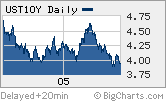 |
 |
| The "conundrum": U.S. Treasury yields have fallen even though the Fed has raised interest rates eight times in the past year. |
|
|
|
|
|
| More about the Fed and economy
|
|
|
|
|
|
|
NEW YORK (CNN/Money) -
Before everyone takes off on Friday to celebrate the long 4th of July weekend, there's a meeting down in Washington that could give the market an early fireworks show.
The Federal Reserve's two-day meeting began Wednesday, and when it concludes on Thursday, it's all but a given that Fed chief Alan Greenspan and company will raise the central bank's target for the federal funds rate, an overnight bank lending rate, a quarter point to 3.25 percent -- which would be the ninth consecutive hike since last June.
But there's a lot of guessing about what the Fed will say, and what its statement will mean for the economy -- and investors.
The Fed has been saying since last May that it planned to keep raising rates "at a pace that is likely to be measured," which investors have bet means more quarter-point hikes, with the Fed more worried about inflation than a slowing economy.
Economy fizzling like a dud...
But recent signs of weakness in the manufacturing sector and record-high oil prices have some concerned about another soft patch, after the brief one last spring. In addition, there are worries that sluggish economic growth in Europe could spread to the U.S.
"There are some indicators suggesting a bit of a slowdown. That could cause the Fed to pause," said Brian Stine, investment strategist with Allegiant Asset Management, a mutual fund firm based in Cleveland. "The key is about how the Fed talks about the economy, if they talk about weakness worldwide and rising oil prices."
Still, many economists say the Fed will raise short-term rates at its next meeting in August, bringing the fed funds rate to 3.5 percent.
At that point, some argue, the Fed could stop and see the effect its rate increases have had on the economy. But for the Fed to show investors that it's almost done raising rates, it might need to get rid of "measured" from its statement.
"I think the Fed will drop the 'measured pace' language," said John Derrick, director of research with U.S. Global Investors, a mutual fund firm based in San Antonio. "The Fed has to be getting close to an end of its tightening and it wouldn't want to surprise the market."
...or soaring like a bottle rocket?
But other analysts argue that relatively tame inflation and a strong housing market paint a healthier portrait of the economy, meaning more rate hikes to come.
"I think the Fed will keep in 'measured pace.' There is no need for a major shift in the statement because economic conditions are similar to what they've been during the past couple of meetings," said Vincent Boberski, chief economist at RBC Dain Rauscher. He sees the fed funds rate at 4 percent by year-end.
And despite comments from renowned bond investor Bill Gross this week that the Fed may actually cut rates later this year, and news that some European banks are hinting at rate cuts, it seems unlikely that the Fed would shift course so quickly and begin to lower rates unless the economy took a nose-dive.
"I'd be awfully surprised if the Federal Reserve starts taking its cue from the central bank of Sweden or the Bank of England," said Boberski, referring to the Swedish central bank's rate cut on Tuesday and support from two members of the Bank of England for a rate cut earlier this month.
In addition, since the yield on the 10-year Treasury remains below 4 percent, some think the Fed has a couple more rate hikes before it would pause. Greenspan has called it a "conundrum" that the long-term rates set by the market are falling while the Fed has been raising short rates.
"For all intents and purposes the Fed is going to move at a measured pace whether that word is in there or not," said Richard Yamarone, director of economic research at Argus Research. "And now, the longer end of the yield curve should react more to Fed moves."
Yamarone thinks the Fed will raise rates next week by a quarter-point and will do likewise at its August and September meetings, which would bring the fed funds rate up to 3.75 percent.
And Chris Probyn, chief economist with State Street Global Advisors in Boston, said he sees no reason for the Fed to stop raising at all this year, which would leave rates at 4.25 percent heading into 2006. He said the eight rate hikes since last June have yet to significantly dampen economic growth and that higher oil prices haven't caused a major dent either.
The economy grew a relatively strong 3.5 percent in the first quarter. So Probyn thinks the Fed should keep doing what it has been doing.
"I think the Fed keeps going as long as GDP growth stays between 3 percent and 4 percent. That would be not too hot to make them go faster or too cold to make them pause," said Probyn.
But does the Fed run the risk of raising rates too aggressively? There is a debate about to what will happen to longer-term bond yields if the Fed keeps tightening and what that would mean for the economy.
For more on that story, click here.
For a look at bond rates, click here.
For more about the red-hot housing market, click here.

|